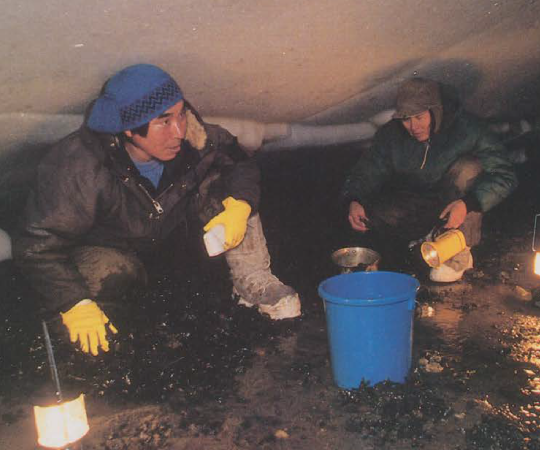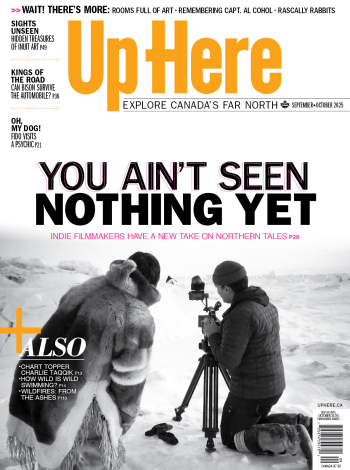This is the story of the past 35 years. This is the story of the North, as only Up Here could tell it.
Click here for the First Decade.

THE SECOND DECADE: 1994-2004
The last brick of gold was poured at Giant Mine in November 1999. It marked the end of the millennium and the end of the Northwest Territories’ golden age of mining. Royal Oak went into receivership shortly after. The mine’s remaining assets were sold off and within a decade the site was officially abandoned.
Over its 50-year life, Giant produced 7 million ounces of gold and 237,000 tonnes of arsenic trioxide. Great piles of the toxic dust still rest beneath the mine—a legacy that’s perpetually the responsibility of the federal government.
Meanwhile, as Giant and Con Mines closed up shop, the NWT’s diamond industry was booming. By 2003 both Diavik and Ekati were pulling record-breaking stones from the ground, including a whopping walnut-sized 151-carat gem from Lac de Gras.

It was here, in our magazine’s second decade, where we also said goodbye to several northern legends. Fred Henne, Yellowknife’s longest-serving mayor, died in 1998 at the age of 84. Ice-road pioneer John Denison passed away in 2001, also at the age of 84. And in 1995, C. H. “Punch” Dickins died at the age of 96. Dickins was the epitome of the northern bush pilot. He was the first to cross the Barrens and the first to cross the Arctic Circle. His adventures defined an age of exploration across Canada’s northern airways for nearly 50 years. Punch’s ashes were scattered on the same Mackenzie River he flew over so many times.
Elsewhere, Prime Minister Jean Chretien’s idea in 2000 to rename Mount Logan after the recently deceased Pierre Trudeau was met with fierce opposition from Yukoners. Iqaluit unveiled its 75 new street names in 2002 in an effort to shorten emergency response times. Firefighters prior often had to respond to calls with directions such as “the house that used to be yellow, next to where Joe and his second wife live.” In 2003, the Nahanni National Park Reserve celebrated its 25th anniversary of being named a UNESCO World Heritage Site. Rob Edge and Stephen Dunbar held the Yukon’s first same-sex wedding in 2004, just days after winning the right to gay marriage.
By 1996 the skies over the North were filled with aircraft, avians, and unidentified objects. There were 46 airline companies servicing the territories that year. It was also in 1996 that a cluster of UFO sightings was reported in Fort Resolution. A meteor the size of a delivery van flew over the Yukon on January 18, 2000, lighting up the sky and producing a thunderous boom before it crashed near the B.C. border. And in 2003 we lost Canus, the whooping crane stud. The famous bird had sired 186 babies over his nearly 40-year life and helped conservationists across the continent save a species that was on the brink of extinction. His frozen body was brought back to Canada from the Maryland wildlife refuge that had been his home and was made part of the permanent collection at Fort Smith’s Northern Life Museum.

In the arts, Susan Aglukark continued her rise to fame in 1995, taking home her first two Juno awards for the triple-platinum album, This Child. Tom Cochrane embarked on a trip to Ragged Ass Road in 1996, and Yellowknife’s Leela Gilday won four Canadian Aboriginal Music Awards in 2002 for her debut album, Spirit World, Solid Wood.
An impromptu concert in a Resolute Bay storage shed in 1996 featured two of the biggest rock bands in the world. The Red Hot Chili Peppers and the Violent Femmes were playing a Molson Ice Beer luxury cruise when rocky weather forced their converted Russian icebreaker to shore. Resolute’s hospitable residents helped the party-goers prepare an indoor concert space and, as thanks, the entire town was invited to enjoy the show. “Even elders came to check out the excitement,” we wrote, “making good use of the earplugs distributed by concert organizers.”
Fort Smith’s Richard Van Camp was only 24 in 1996 when the Tłįchǫ author released his debut novel, The Lesser Blessed, to widespread critical acclaim. Rising fashion star D’arcy Moses was 32 in 1997 when he left behind Montreal’s runways to rediscover his northern roots in Wrigley, NWT. Inuk filmmaker Zacharias Kunuk was 43 when Atanarjuat: The Fast Runner debuted at Cannes in 2001. Jordin Tootoo was 18 that same year when he signed with the Nashville Predators to becomes the first Inuk NHL player.
In 2000, a visual artist led an impromptu throat-singing performance to close out the Great Northern Arts Festival. “We kind of just thought of it right before the show,” she told Northern News Services Ltd. In the audience were two Icelandic tourists with a video camera. A year later, the singer was on tour with Björk and the world was introduced to Tanya Tagaq.

The millennium ended with a bang as Canada welcomed its newest territory. Nunavut was born on April 1, 1999. It was a celebratory moment for the Inuit homeland and a historic event for all Canadians. Ever since the Nunavut Land Claims Agreement was signed six years prior, officials in the eastern Arctic had been working at breakneck speed to build the administrative infrastructure that needed to be in place for Nunavut’s 1999 birthday. Flags had to be designed. Departments created. A brand new government had to be built from the ground up. An election needed to be organized. When April 1 finally arrived and the fireworks exploded in the sky over Iqaluit, a new future for the North was solidified. Not everything went smoothly, though.
As the logistics for separating one territory into two were worked out, a committee of western Arctic politicians decided the Northwest Territories should keep its famous polar bear license plate, even though the vast majority of polar bears live in Nunavut. A fierce battle over the famous license plate shape ensued before both sides relented.
The plate battle was one of several identity crises the NWT underwent throughout Nunavut’s separation. Famously, the territory decided its name could use a revamp and solicited the public for help. Second-place in the resulting poll went to “Bob.” The joke choice drew 81 votes. In first place with 6,111 votes was the tried-and-true “Northwest Territories.”
Despite the upheaval and Y2K panic down south, for many residents in the North life continued on as it had before. On December 31, 1999, Grise Fiord held a Last Seal of the Millennium hunting contest. Six women headed out at 1pm in total darkness. Meeka Kiguktak came back 34 minutes later with her catch, winning a $250 prize.
“It’s what we do every year,” she told the press. “I wasn’t even thinking of the millennium.”









